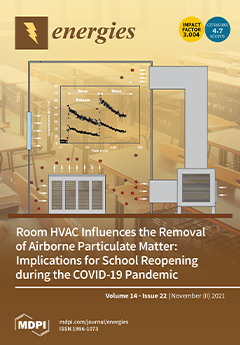Turbine as a key power unit is vital to the novel supercritical carbon dioxide cycle (sCO
2-BC). At the same time, the turbine design and optimization process for the sCO
2-BC is complicated, and its relevant investigations are still absent in
[...] Read more.
Turbine as a key power unit is vital to the novel supercritical carbon dioxide cycle (sCO
2-BC). At the same time, the turbine design and optimization process for the sCO
2-BC is complicated, and its relevant investigations are still absent in the literature due to the behavior of supercritical fluid in the vicinity of the critical point. In this regard, the current study entails a multifaceted approach for designing and optimizing a radial turbine system for an 8 MW sCO
2 power cycle. Initially, a base design of the turbine is calculated utilizing an in-house radial turbine design and analysis code (RTDC), where sharp variations in the properties of CO
2 are implemented by coupling the code with NIST’s Refprop. Later, 600 variants of the base geometry of the turbine are constructed by changing the selected turbine design geometric parameters, i.e., shroud ratio
, hub ratio
, speed ratio (
) and inlet flow angle
and are investigated numerically through 3D-RANS simulations. The generated CFD data is then used to train a deep neural network (DNN). Finally, the trained DNN model is employed as a fitting function in the multi-objective genetic algorithm (MOGA) to explore the optimized design parameters for the turbine’s rotor geometry. Moreover, the off-design performance of the optimized turbine geometry is computed and reported in the current study. Results suggest that the employed multifaceted approach reduces computational time and resources significantly and is required to completely understand the effects of various turbine design parameters on its performance and sizing. It is found that sCO
2-turbine performance parameters are most sensitive to the design parameter speed ratio (
), followed by inlet flow angle
, and are least receptive to shroud ratio (
). The proposed turbine design methodology based on the machine learning algorithm is effective and substantially reduces the computational cost of the design and optimization phase and can be beneficial to achieve realistic and efficient design to the turbine for sCO
2-BC.
Full article





